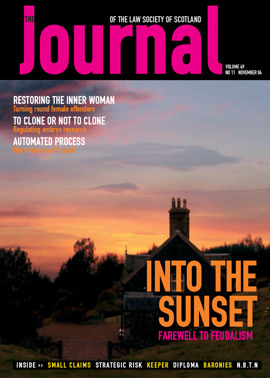Shredding the evidence

In April 2003 the Sheriff Court Rules Council established an IT subcommittee to identify the areas in the civil court in which information technology could be more widely used. It did so in the belief that the carefully devised use of IT is essential to the efficient and economic delivery of the services of the sheriff’s civil court to the public in the 21st century.
The committee has recently made 10 recommendations. The first seven relate to ordinary causes and summary applications. Recommendations 8 and 9 are concerned with summary causes and small claims. Recommendation 10 is concerned with changes in the rules of procedure. The recommendations are:
The digital writ
1. “Electronic transmission, lodging and storage of the following documents should be competent: (a) Initial Writs/Petitions/ Applications; (b) Notice of Intention to Defend; (c) Defences/ Answers; (d) Closed Record; (e) Motions; (f) Minutes”
The committee believes this will produce significant efficiency gains and monetary savings to the benefit of courts, solicitors and individual users of the court system.
In my view, this is unarguably a good proposal. To take one example, it currently takes up to a week for an initial writ to be returned by courts after submission for a warrant. This process could be automated in such a way that it would take a matter of minutes.
The proposals would also result in a reduction in paper – good for the environment and a step closer to the all-too-elusive paper-free office. A further benefit would be the delivery of certainty and security that documents have reached their destination to an extent that is simply not possible using traditional communication. Think of the records you send before options hearings that could go missing in the post or document exchanges.
The committee did not address the electronic transmission and storage of productions. This matter is to be considered separately but there seems no reason why productions of a modest size and number could not be held electronically.
2. “All interlocutors pronounced by the court (including warrants granted by sheriffs and clerks) should be transmitted electronically to agents (and party litigants where they wish to avail themselves of this service)”
The committee again concluded that there was the potential to make significant efficiency gains with the interlocutor reaching parties much more quickly than would otherwise be the case. Again this can only be a good thing. Abolishing the stress of dealing with a G5 lost in the post would bring significant health benefits to the profession.
3. “The system should be operated by use of a website that provides positive confirmation of receipt”
This proposal would ensure consistency of the format of data and avoid a number of potential technical issues. My own firm provides many clients with online web pages on which to instruct it – for them at present, and for future users of the proposed system, this method is no more difficult than using the internet for any purpose.
No need to delay
4. “After a short pilot scheme, the system should be introduced in all the courts in Scotland”
The committee believes the pilot of the website system should be very short and that thereafter it should be introduced to all sheriff courts.
I welcome that approach as it would ensure a consistent nationwide approach and the same access to justice for all in Scotland, wherever they are geographically.
5. “The electronic system should be operated by the Scottish Court Service in parallel with the existing paper system for a period of two years after its introduction. Thereafter it is proposed that only in limited or exceptional circumstances or on cause shown should the paper system be used by solicitors”
During this period solicitors would be entitled to lodge papers either in hard copy or in electronic form. However, the committee proposes that once the period of two years has elapsed, only in exceptional circumstances would hard copy papers be accepted. It is not proposed that party litigants should have to use the electronic system.
The system will not work if parallel systems are allowed to continue indefinitely. In my firm’s submission we argued that one year for the parallel system would be sufficient.
6. “There should be a statutory provision that removes the need for a manual signature”
The committee formed the view that manual signatures would require to be removed where at all possible; and where signature was essential, a secure electronic signature should be introduced.
This seems inevitable if the system is to work at all. Adequate security measures will be required. In the equivalent system for England and Wales (see below), a unique user code is provided to every participating firm. Every time a firm wishes to submit a file it must electronically provide a cover note which formally confirms the matters it wishes the court to process.
7. “Consideration should be given to the provision of other facilities such as parties being able to view the case on line”
The committee had concerns about confidentiality, but at the same time recognised the need for parties to be assured that their motions and so on were being dealt with and to obtain the information they needed. The committee made no firm recommendation to the Rules Council on this point and it was agreed to seek wider views.
There are now at least half a dozen firms in Scotland who offer online case tracking access to their clients and it is worth noting (in case it should be thought otherwise) that they are not all urban or central belt firms. These systems provide tremendous efficiency benefits by lowering the need for updating phone calls and the like. The Scottish Courts Administration could enjoy the same benefits.
Virtually there already
8. “There should be a centralised virtual court. In the first place every [summary cause and small claim] would go electronically to this single site and unless it was defended or a hearing was otherwise required, it would be dealt with entirely electronically at this site”
The intention here is that all such actions should be lodged in electronic form and transmitted to a single site or “virtual court”. Unless they were defended or would otherwise require a hearing, these cases would be dealt with entirely electronically at this location. Defended cases and those otherwise requiring a hearing would be transmitted to the appropriate local court for this purpose.
The committee believes there would be efficiency and cost benefits. The committee’s view is correct. How do I know?
For the past year and a half, my firm has been linked into the virtual court of England and Wales, through our Manchester office. This works in the same way as is now proposed for Scotland.
An IT file is issued by email to the court. In our case, this captures data from our system but it could equally be completed manually. Within reason, there is no limit to the number of applications for the same step of process – to raise an action, apply for judgment or apply for a warrant of execution (a form of diligence against moveable property) – that can be made within the same file.
The virtual court is willing to accept a small number of errors in any one file, rejecting those with errors and processing the remainder. If there are more than 10 errors in a file, it will be returned entirely.
After submission of a file for raising actions, confirmation that the actions have been served by the court (note the ninth recommendation below) is sent out and arrives with us, usually no more than 48 hours after submission. As the actions are served at the same time the confirmation is sent to us, it follows that court papers are being received by defendants (defenders to the Scots) within 48 hours of the action being raised. How many actions in Scotland currently enjoy those timescales?
Similar efficiency is seen in the processing of applications for judgment and dealing with warrants of execution. It is worth noting that all types of what we might call “decree in absence” (and one form of what we might call “decree by default”) can be applied for electronically: actions with no response by the debtor at all; actions where the debtor wholly or partly (to your client’s satisfaction) admits the sum sued for; actions where the debtor wishes time to pay; and actions where the debtor lodges an acknowledgment (like an NID) but fails as required to follow this up timeously with a defence.
If a matter is defended, the case is transferred out to the local court, determined by the location of the parties, and then becomes like any “normal” defended action.
Of course the system has its limitations. At present, it deals with money-only claims and has a maximum cap on the sum claimed of £100,000. Any action for the equivalents of return of goods, ejection, interdict, declarator and so on is incompetent and must be dealt with traditionally. But where it does apply, the system brings significant cost and efficiency gains.
9. “The sheriff clerk should serve all summary cause and small claims actions”
For solicitors, this would mean we would no longer have to carry out a task which forms a significant part of undefended litigation.
The tenth and final recommendation is simply that “The Secretariat should search the primary and secondary legislation to identify where changes will be required.” Definitely a good idea!
Mark Higgins is a partner in Golds, Glasgow
In this issue
- Drafting consumer contracts
- Virtual firms: transactional learning on the web
- Ignorantia juris: it's all Greek to me
- Sheriff Court Rules Council consultation paper
- The Clinical Trials Directive - a summary
- Guarding the inner sanctum
- Neighbours in the global village
- Family law: is it the path for you?
- From sunset to sunrise
- What next for conveyancing?
- An ethical minefield
- Shredding the evidence
- Robbing the poor?
- Our dynamic profession
- A wider angle
- Keep the eye on the ball
- A rough guide to becoming a partner
- Rediscovering hope
- Sharpen your pencils
- Significant other
- Too far or not enough?
- Chipping away the infringers?
- View from Holyrood
- Website reviews
- Book reviews
- The Registers and the Appointed Day
- Feudal law: not just a relic
- Birth of a register






